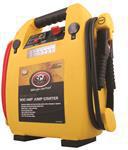12 month warranty. My last one (smaller SCA 600amp) lasted 4 years.
Great as a long lasting light during power outages, or camping.
Reading reviews, a lot of people use them for powering small fridges overnight while camping etc.
Features & Benefits:
Combined audible & visual warning system when charging is required
Inbuilt spark & surge protection
Reverse polarity alarm
Super bright LED work light
Suits 4 cylinder petrol engines up to 2 litre capacity
Blurb:
A jumpstart battery pack is an incredibly useful tool for those terrible situations when you turn the ignition key and nothing happens due to a flat battery. Whether the battery is on its way out, or even if the problem is as simple as the lights being left on in the car, the SCA 900 Amp Heavy Duty Jumpstart is sure to get you out of more than one tricky situation. Being a 900 Amp jumpstart battery pack it is ideal for jump starting small to medium sized 4 cylinder cars. This jumpstart pack is simply pre-charged via a 240V wall socket and can then be left in the car or garage for when needed. When further charging of the battery pack is required, both visual and audible warnings are given, meaning you will never be left with both a dead battery and dead jumpstart pack. Additionally, this jumpstart pack has twin 12V accessory outlets, which provides a power source for 12V powered items and will remove the strain off the car battery.




While this a good deal I wouldn't recommend buying one of these to take up your boot space and lug around the 15kg battery box for that rare moment you'd have a flat battery.
I'd get one of these that will easily fit in your glove box and still jump start your car and charge your phone just like this big bulky unit.
I guess the pro of this big unit is that it should do multiple jumps between charges..